Just want to report that both broody hens seem to have accepted their clutches. Despite dreaming Tuesday night that I awoke to find they had smashed all the eggs, everything was quiet when I opened the garage. Both hens are in the broody zombie state, and all looks good.
I forgot to mention a little ringer I threw into this project, just to keep it interesting. On Tuesday afternoon I met a lady at a gas station off Route 29 in Madison for a quick deal. She jumped out of a maroon minivan with a taped-over tail light as I pulled up behind the building. She handed me an egg carton containing six eggs, I forked over a $20, and lickety split, we separated and hit the road in different directions.
It was at its heart a true CraigsList deal. A few e-mails exchanged beforehand, a quick phone call, an arrangement to meet at a blessedly public place. My prize? Six Coronation Sussex hatching eggs.
Now, if you’re not familiar with the Coronation Sussex, allow me to introduce you:
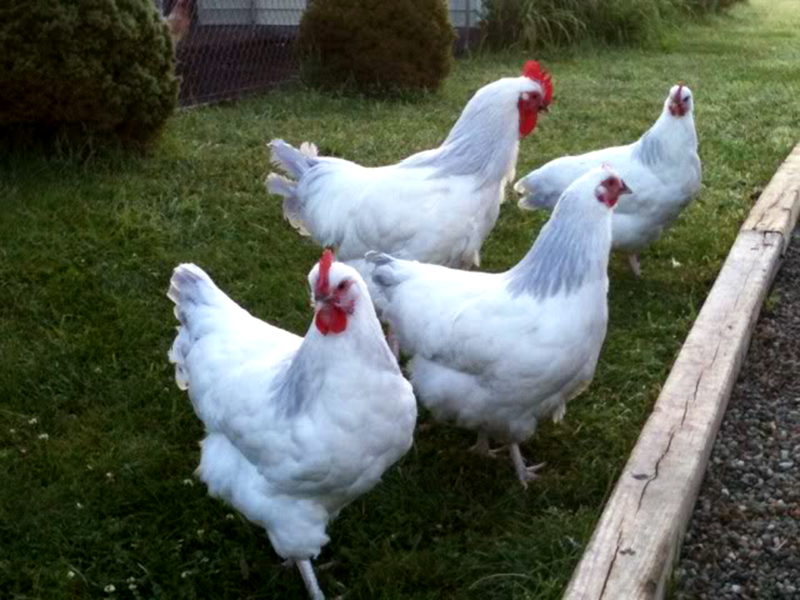
(Photo from BJs Poultry)
Pretty chickens, huh?
The eggs I bought supposedly come from Greenfire Farms lines, and you can read all about them and see more photos here. However, as with any CraigsList deal, you can never know. They could be store-bought eggs pulled from the fridge minutes before flying out the door. And, as with the purchase of any hatching eggs, one is never guaranteed a success. Don’t count your chickens…
Regardless of these known unknowns, I figured I’d give it a try. I’m not in the business of maintaining any fancy chicken bloodlines, so if I get a couple of pretty birds out of the deal that’s good enough for me!
Oh, and a very exciting possible farm development is underway. On Saturday I am visiting a farm over the mountain to talk to a lady about some baby goats. To, you know…just…visit…
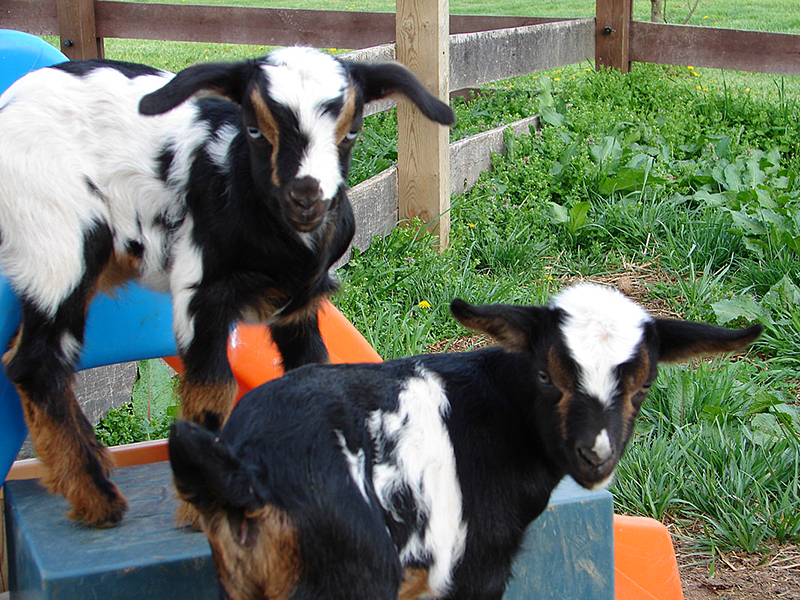
Stay tuned!
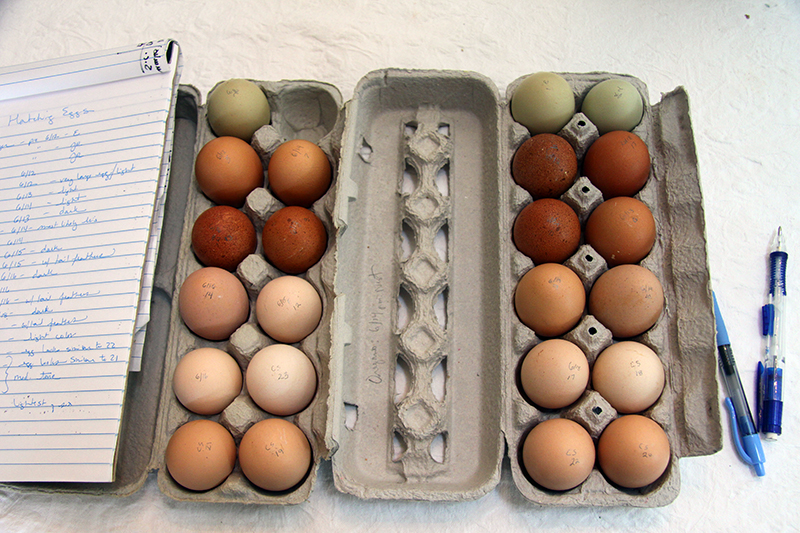
There are just a few intimate acts that are on par with reaching, in the dark, beneath a broody hen’s body, into the damp heat of her defeathered breast, feeling for eggs that pulse with embroynic blood. My years of developing film and photographs in the darkroom served me well as I navigated by feel alone. Oregano gave me a few good pecks on the wrist, bless her defensive spirit, and Dahlia let loose with a series of low perturbed squawks as I mussed about beneath her.
I took Oregano’s sacrifical eggs from her and and placed them in an old cardboard box grabbed off the garage floor, stretching as I did through the sticky web of a mother spider guarding her egg sac.
And then I replaced the stolen neverbabies with twelve fresh eggs for Oregano and eleven for Dahlia, of all colors and shapes, with a prayer for the suspended lives within.
And the 21-day countdown begins toward life or no life. It all comes down to the proper application of heat and humidity. Amazing, every time.
Ever since April I’ve been hoping one of my hens would go broody and hatch some chicks. Why? Because baby chicks are some of the things that make life worth living, of course. That and I am seriously curious to see what kind of crosses would result from my Wheaten Ameraucana rooster over Black Copper Marans, Lavender Orpingtons, a Barred Olive Egger, and whatever mix Lilac and Iris are (Black Australorps and Mottled Java, according to their breeder).* Iris and Lilac are in their second year of lay, and it’s good to have younger pullets coming along to take over egg-laying duties. And finally, now that I am free-ranging the birds outside most days, I anticipate that at some point I will have predator loss and don’t want to be caught out with not enough laying hens to keep eggs in the fridge.
A broody hen is a wonderful creature because she manages all the care, feeding, and warming of young chicks. If you have ever raised chicks, you know that it’s a big, messy job to monitor their brooder temperature, clean up after them, keep them safe from drafts and predators, and make sure they get enough to drink and eat. So I told myself that the only way I would raise chicks this year was if a hen did all the work for me!
Last year Iris went unbreakably broody and I ended up giving her a clutch of fertile guinea eggs. She brooded them in a dog crate in the garage and hatched out and raised nine guineas. Here’s one at several weeks old, posing for its CraigsList portrait:
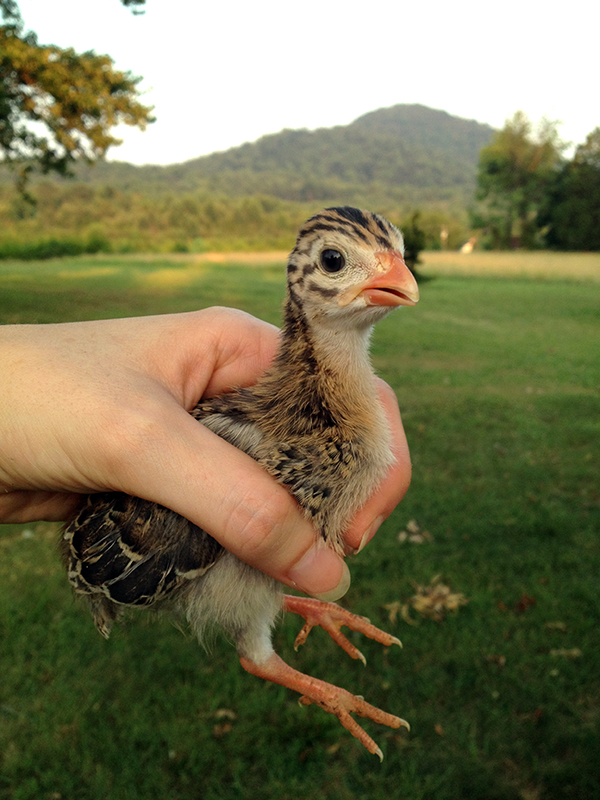
I got to watch the hatch and meet the still-damp keets, and it was one of the neatest days of my life. But this year, Iris has chosen to not do it again. Being trapped in a small cage with nine flighty, frantic, velociraptor-looking guinea keets was probably enough for her to sign off on motherhood forever. Not that I blame her—check out how those ravenous minidinosaurs are eying up their adopted mother’s toes while Iris pleads with her eyes for a Calgon moment.
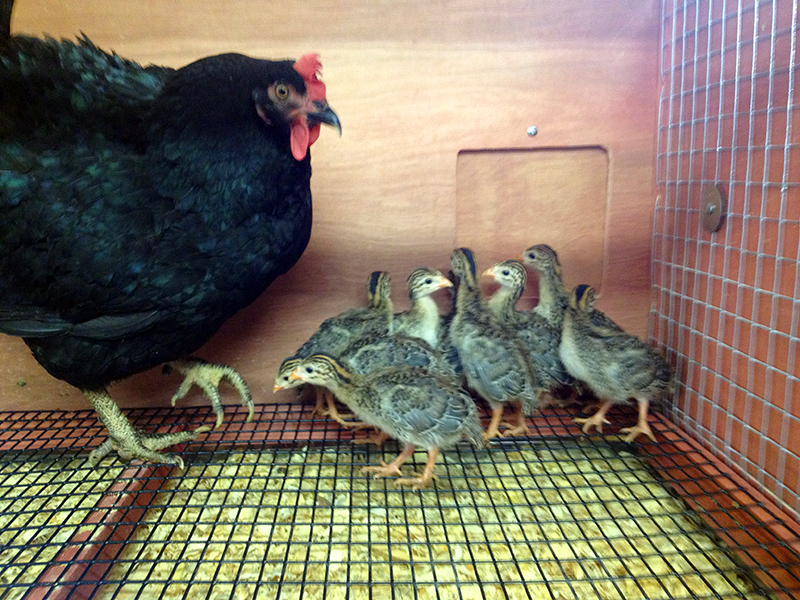
The most time-tested way to induce broodiness in a hen is to let eggs accumulate in the nest box. When the hen feels a growing clutch beneath her, some hormone switches in her brain that tells her to buckle down and brood. She will remain on the nest, barely eating and drinking, and will often pull feathers out of her breast so that she can keep the eggs tucked right next to her bare skin.
For weeks now I’ve been letting eggs accumulate, rotating out the older ones after a day or two in order to keep some in the fridge. I also placed the infamous glass eggs in the nests to trick the hens in to thinking there were always eggs waiting for a mother. And finally, it started to look like a few of then hens were beginning to feel broody.
Oregano, my beautiful barred olive egger, was the first to show any sort of devotion. After she’d been on the nest about a week, I fixed up a broody coop in the garage and built her a cardboard brood nest. It’s best to have a hen incubate eggs and raise chicks in a quiet, private place away from the bustle of the main coop, where flock mates may see new babies as tasty hors d’oeuvres. I was waiting for nightfall to move her to her new home when one of my Black Copper Marans saw the nest was exposed and jumped up to sit on the eggs.
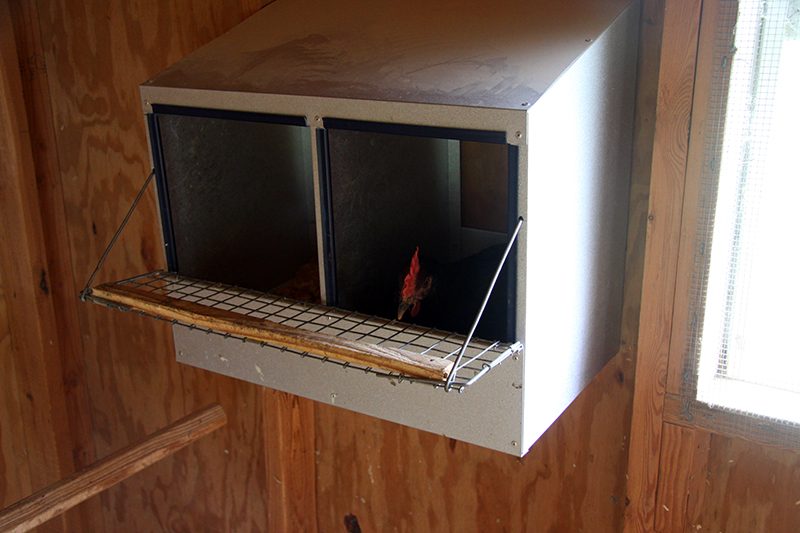
After dark, when I went to collect Oregano, the Black Copper Marans was still sitting tight on the eggs. One look and I got her message: She wanted a clutch of her own.
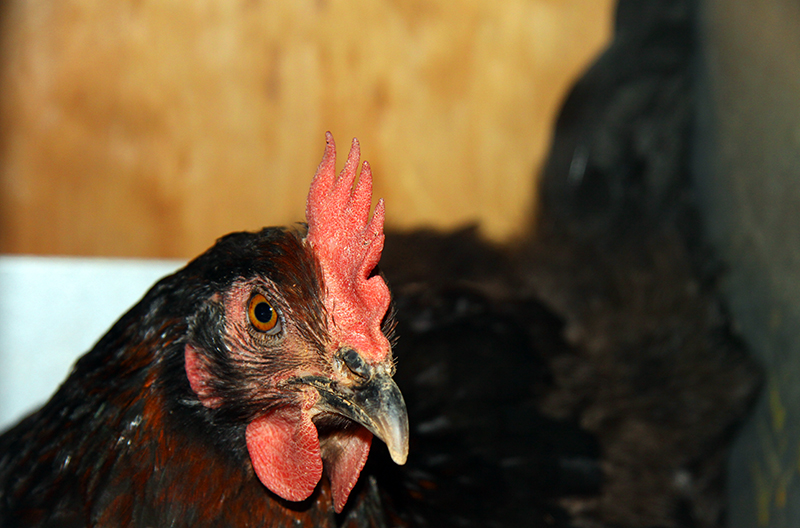
Oregano had assumed a broody position in the adjoining nest box. So I grabbed her and moved her and the eggs into the garage coop.
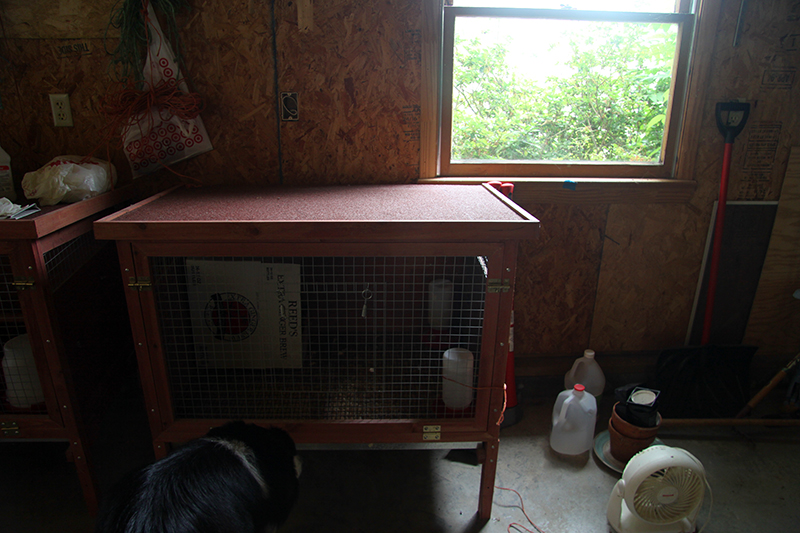
Oregano accepted her new nest and has stayed on it since Friday.
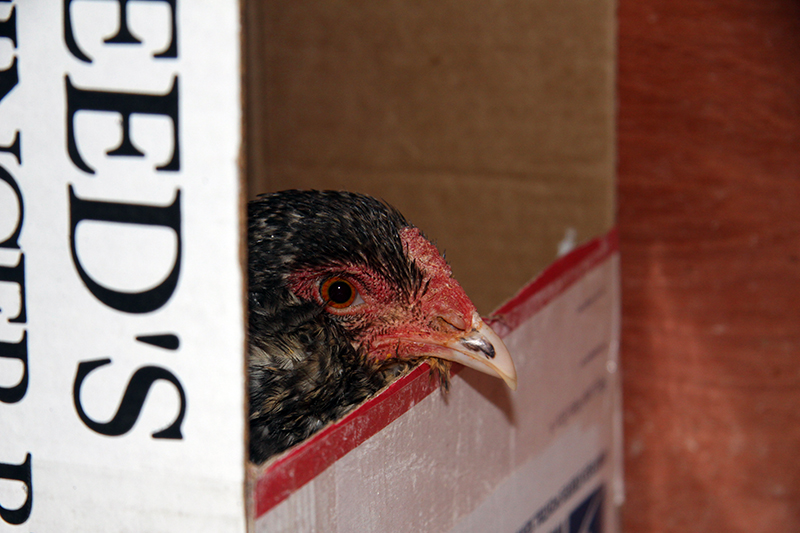
But the Black Copper Marans was still sitting on the glass eggs. And so I fixed up a second broody coop in the garage, built another cardboard next box, and last night moved her into a brood cage next to Oregano. So now I have two broody hens.
I have been saving out eggs for a week or so now, and when I get numbers I am satisfied with I will remove the glass and sacrificial eggs from under the hens and replace them with these fresh eggs. That way all embryos will start to develop at once, and all chicks will hatch at the same time. It’s a bit sad as the eggs are developing under Oregano, but their job really is to just “hold” the hen in a broody mindset until the more valuable eggs are introduced.
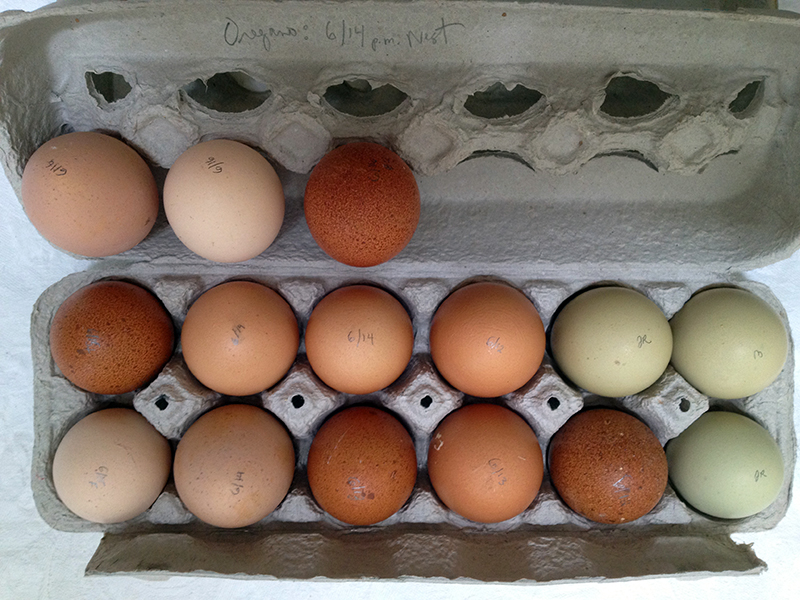
I wasn’t really planning on trying to raise two clutches, but at the end of the day it’s not such a bad thing. It means I can hatch more eggs, which is good as there is no way of knowing what the fertility rate is amongst my hens’ eggs. And, if one of the hens begins incubating and gives up, I could move the most valuable eggs to the other hen and have her take over. Thus, I am waiting until the same night to give both hens their eggs, and then we will see what happens! There is still a lot that can go wrong in the 21 days it takes to cook a chick, but I am having fun working with my broodies. If you’d like to know more, allow me to refer you to this excellent article by my favorite author on all things chicken, Harvey Ussery: Working with Broody Hens.
*A quick digression on chicken breeds and egg color: I have the right set-up to produce olive eggers, which, as their name suggests, lay olive colored eggs. To make a nice olive egger, you need a dark brown egg-laying breed (such as Black Copper Marans) mixed with a blue egg laying breed (Wheaten Ameraucana—my rooster). My Black Copper Marans don’t lay very dark eggs and I have no idea what sort of blue egg genetics my rooster carries, so I don’t suspect I will break any records with any pullets I hatch from that combination. But at the very least, I should end up with some sort of green egg, which is plenty exciting to me.
Now here is where it gets interesting. I have three eggs saved out from Oregano, my barred olive egger (the green eggs in the photo above). She does lay a very nice olive-colored egg, when she lays. By crossing her with Calabrese, and his blue egg genes, I may end up with a pullet that lays a really green egg, as opposed to an olive egg. But who knows, really? I have read about chicken genetics until I fell over from confusion and still am not sure what will happen. Mostly because I know nothing about the genetics of the birds I am starting with, other than their supposed breeds and what color eggs the hens lay now. And there’s always the possibility that I will hatch 100% cockerels and then the whole experiment is good for nothing but the freezer. And even if I do hatch pullets, it will be another year until they lay and who knows if I will even be in to chickens then!










